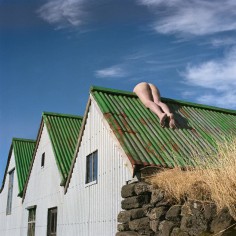Scarlett Hooft Graafland
Roofs

source: thepolysh
來自荷蘭的攝影師 Scarlett Hooft Graafland 最有一輯名為「roofs」的作品,一九九九年從荷蘭海牙 Royal Academy of Fine Arts 畢業,其後就一直專注拍攝事業的發展。可愛又有特色的作品非常多,全部都色彩豐富又有格調;看起來讓人有種很高興的感覺,就算是憂悶的心情一下子都變得很舒暢!
名命名為「roofs」(屋頂)的相集到底是什麼?可愛又搞怪的 Scarlett Hooft Graafland 就是要給我們特別的裸照紀錄!這種裸照感覺一點都不暴露,又沒有色情的原素。看上去,讓人感到的都只是天然氣息,和自由自在的空間感!我覺得這樣很重要,一張照片所有出來的感覺,除了看的人自行的詮釋之外,也要看拍攝者的功力。藝術和色情,有時只是一線之隔;你要站在那一邊去,除了是你自己的舉步之外,也有部分是原作者的心意。
這個「roofs」的相集並不是最新的作品,但我覺得可以說是攝影師 Scarlett Hooft Graafland 其中最成功的一個。在 2004 年發表的相集,現在看來一點都沒有老土的感覺,依然耐看。說到底,平凡的屋頂和人們的裸體都不是會被時代狠狠影響的東西,也就是耐看的主要原因吧。
我最欣賞當中帶出來的一種快樂的感覺,讓人心廣神怡是最大重點吧!想要看更多來自荷蘭的攝影師 Scarlett Hooft Graafland 的作品,可以按進他的的網頁,按這裡。
.
.
.
.
.
.
.
source: mtrongngaynet
Scarlett Hooft Graafland được đánh giá cao với những tác phẩm thực tế nhưng lại rất sống động và sáng tạo. Loạt ảnh cô gái khỏa thân nằm vắt vẻo trên mái nhà được thực hiện ở miền Tây Ai-xơ-len như một làn gió mới mang âm hưởng ấn tượng và độc đáo.
Trong bộ ảnh với tên gọi “Trên những mái nhà”, Scarlett đã sử dụng kỹ thuật nhiếp ảnh kết hợp với lối thể hiện chân thật và gần gũi. Những bức ảnh “trần trụi” nhưng đầy nghệ thuật giúp người xem cảm nhận được khát khao tự do của một cô gái phóng khoáng, cá tính.
.
.
.
.
.
.
.
source: ignantde
Inhabiting the border between straight photography, performance and sculpture, Scarlett Hooft Graafland’s photographs are records of highly choreographed live performances. For her series ‘Roofs’, Hooft Graafland worked in the western part of Iceland.
She utilizes the medium of photography, associated with the representation of truth, to represent the fantastic and the irrational. The photos are made analog and printed without digital manipulation.
.
.
.
.
.
.
.
source: michaelhoppengallery
Born in the Netherlands in 1973, Hooft Graafland is currently based in Amsterdam. She has studied at the Royal Academy of Fine Arts, The Hague, Bezalel Academy, Jerusalem and Parsons School of Design, New York and has travelled to Iceland, Israel, Canada and the United States for her work. Her work has been exhibited in solo exhibitions all over Europe and as part of group shows at the Metropolitan Museum, New York, and the Musée D’Orsay, Paris amongst others.
Inhabiting the border between straight photography, performance and sculpture, Hooft Graafland’s photographs are records of her highly choreographed live performances in the salt deserts of Bolivia, the Canadian and Finnish Arctic, and rural China. Fascinated by the surreal beauty of the harsh natural landscape she utilises this as her canvas. Anthropologically curious, her ideas emerge directly from the local mythology that originates in this otherworldly environment.
Using naïve and childlike colour palettes her photographs draw on the language of the surreal, showing familiar objects out of context (a llama wearing balloons, top hats flying through the desert and a pair of naked legs entwined around a cactus). Her humorous and unsettling juxtaposition of these everyday objects with the sparse, unforgiving landscape echoes the aesthetic of surrealists such as René Magritte. Hooft Graafland utilizes the medium of photography, associated with the representation of truth, to illustrating the fantastic and the irrational.
‘Vanishing Traces’, a homage to land artist, Robert Smithson, is made out of floating balloons at Laguna Colorada in southern Bolivia. Smithson was inspired to make his original piece after reading about this particular red salt lake (Laguna Colorada) in the book ‘Vanishing Traces of Atacama’ by William Rudolph. Due to the remoteness of the location however, Smithson installed his work in the Great Salt Lake in Utah. Hooft Graafland has returned to the place of his inspiration, with her team, to build her own transient spiral balloon jetty. The clean simplicity of her finished works offer no indication of the difficulties in accessing and working in such inhospitable terrains. Highly dependant on the collaboration of the local people, her journeys are indebted to the assistance of the local people and artists with which she works.
.
.
.
.
.
.
.
source: artslant
In the work of Dutch artist Scarlett Hooft Graafland you find a combination of straight photographic practice with performance and sculpture in which she constantly refers to a more profound cultural discourse of her surroundings. She made extensive travels to various parts of the world to work on projects, such as in the highlands of Bolivia, the south of China, the arctic Canada and the Palestinian Westbank. In these site-specific installations and photo set-ups she would make use of local materials, traditions or techniques. Most recently she is having a soloshow at Michael Hoppen Contemporary gallery in London and a duo show with Jan Bünnig at Autocenter, Berlin and she will participate in the exhibition ‘Slow Art’ at Nuke Gallery in Paris, opening the 20st of February.
Hooft Graafland graduated from the Royal Academy in The Hague, The Netherlands, studied for one year at the post-graduate program at Bezalel Academy in Jerusalem and graduated in 2002 from a MFA in sculpture at Parsons School of Design, New York.
.
.
.
.
.
.
.
source: shft
In the Netherlands, where Scarlett Hooft Graafland grew up, every inch of land is either urbanized or cultivated; there is no “natural” landscape left. That may help explain her fascination with wild, unforgiving landscapes, where she travels to shoot her signature surreal photos that explore the fertile area where the manmade and the natural intersect.
From Bolivia’s altiplanos to the Arctic tundra, Hooft Graafland intervenes in harsh environments to create strange, captivating images that marry photography with performance and installation. The works carry a subtle, underlying message about human impact on the natural world.
Asked about her attraction to desolate places, the artist told Don’t Panic:
“I am mostly interested how local people survive who live in such harsh circumstances – the Inuit in the extreme cold, endless winters on the one hand, and also these Bolivians who live in the Altiplano in the highlands of Bolivia. On the borders of the salt desert, it seems almost impossible to be able to make a living. I like to experience nature as such a strong force. We humans might think we ‘rule the world’ but at the end of the day we are just a tiny fraction.”

